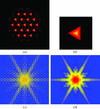issue contents
November 2003 issue

Cover illustration: Simulated diffraction pattern from an array of quantum dots illumunated with an X-ray beam with reduced coherence length, see Vartanyants and Robinson, pages 409-415.
facility information
research papers
The possibilities of imaging quantum dot structures in coherent and partially coherent X-ray diffraction experiments are discussed. It is shown that high-quality images of individual islands can be obtained in these experiments.
The critical conditions for X-ray topography of protein crystals are discussed and demonstrated. Crystal defects, especially dislocations, in tetragonal hen egg-white lysozyme crystals are characterized by synchrotron white-beam topography.
First experiments on diffraction-enhanced imaging have been performed at the XRD2 beamline at LNLS.
The performance of a high-resolution powder diffractometer, which is combined with an undulator X-ray source and a large offset double inclined crystal monochromator, is examined using standard materials at BL15XU, SPring-8.
A high-resolution X-ray diffraction beamline capable of performing X-ray magnetic-scattering experiments has been commissioned at the Brazilian Synchrotron Light Laboratory (LNLS) in Campinas, Brazil.
The status of the diffraction anomalous fine-structure spectroscopy and the recent technical achievements, at the beamline BM2 at the ESRF, are reported. Extended-DAFS data reduction and absorption correction are presented.
Protein crystal quality evaluation using cascade correlation neural networks.
A novel monolithic mechanical bender has been designed and fabricated to meet the requirements of an active polynomial grating at the NSRRC, Taiwan. The design considerations, fabrication processes and testing results are described.
Fluorescence X-rays have been detected in the energy range 300–1500 eV. Demonstration X-ray absorption spectra have been collected for a variety of elements in this energy range, using the fluorescence technique.
The operation and technical capabilities of a new mobile luminescence end-station (MoLES), available for public use at the Daresbury synchrotron radiation source, are described. The system is ideal for the measurement of luminescence emission, optical detection of XAS (OD-XAS) and pump–probe experiments of solid-state samples over the temperature range 8–330 K, excitation range 5 eV to 70 keV, and photon emission range 1.2–6.5 eV.
current events
Free 

Free 

Free 



 journal menu
journal menu





































